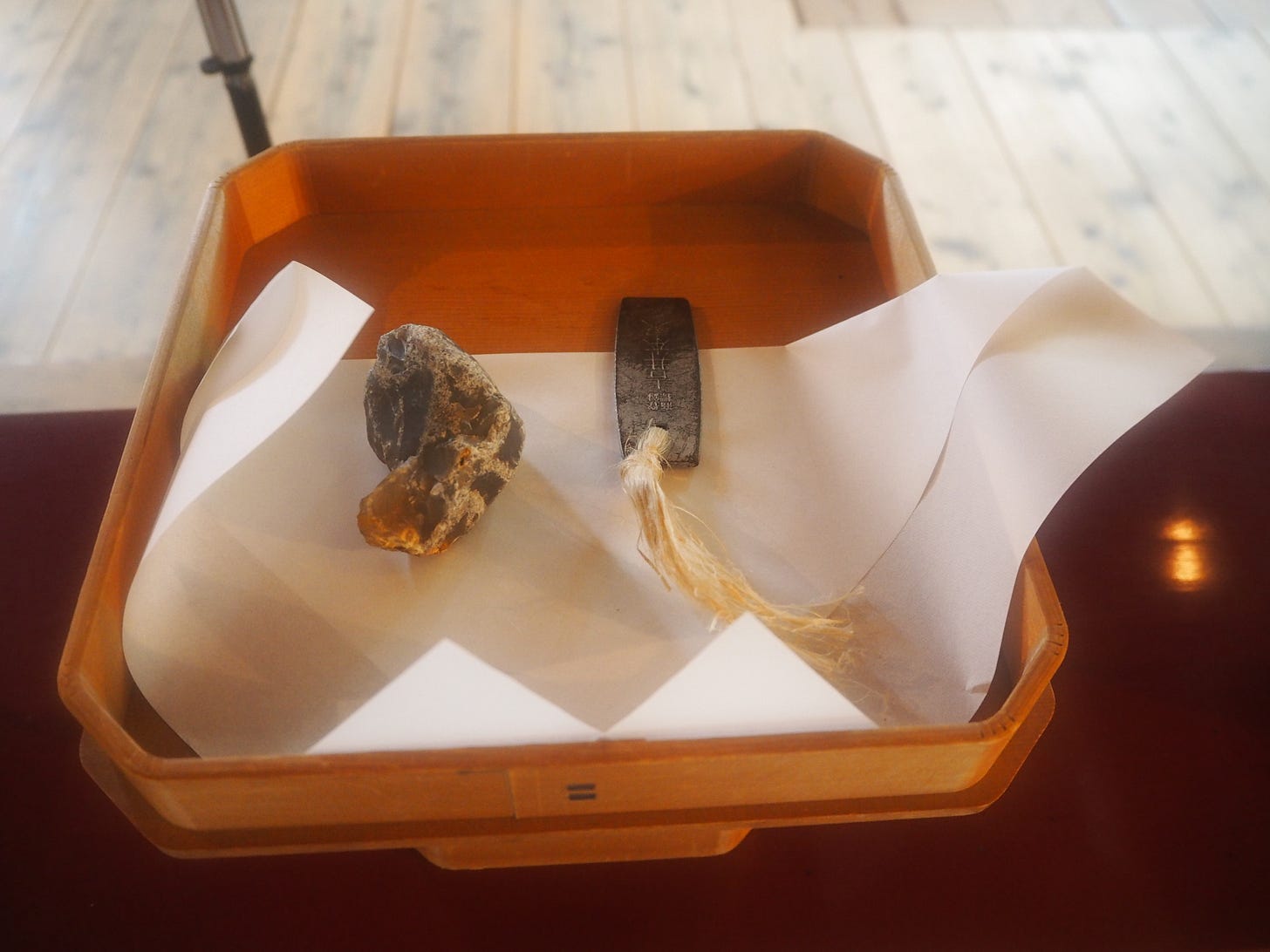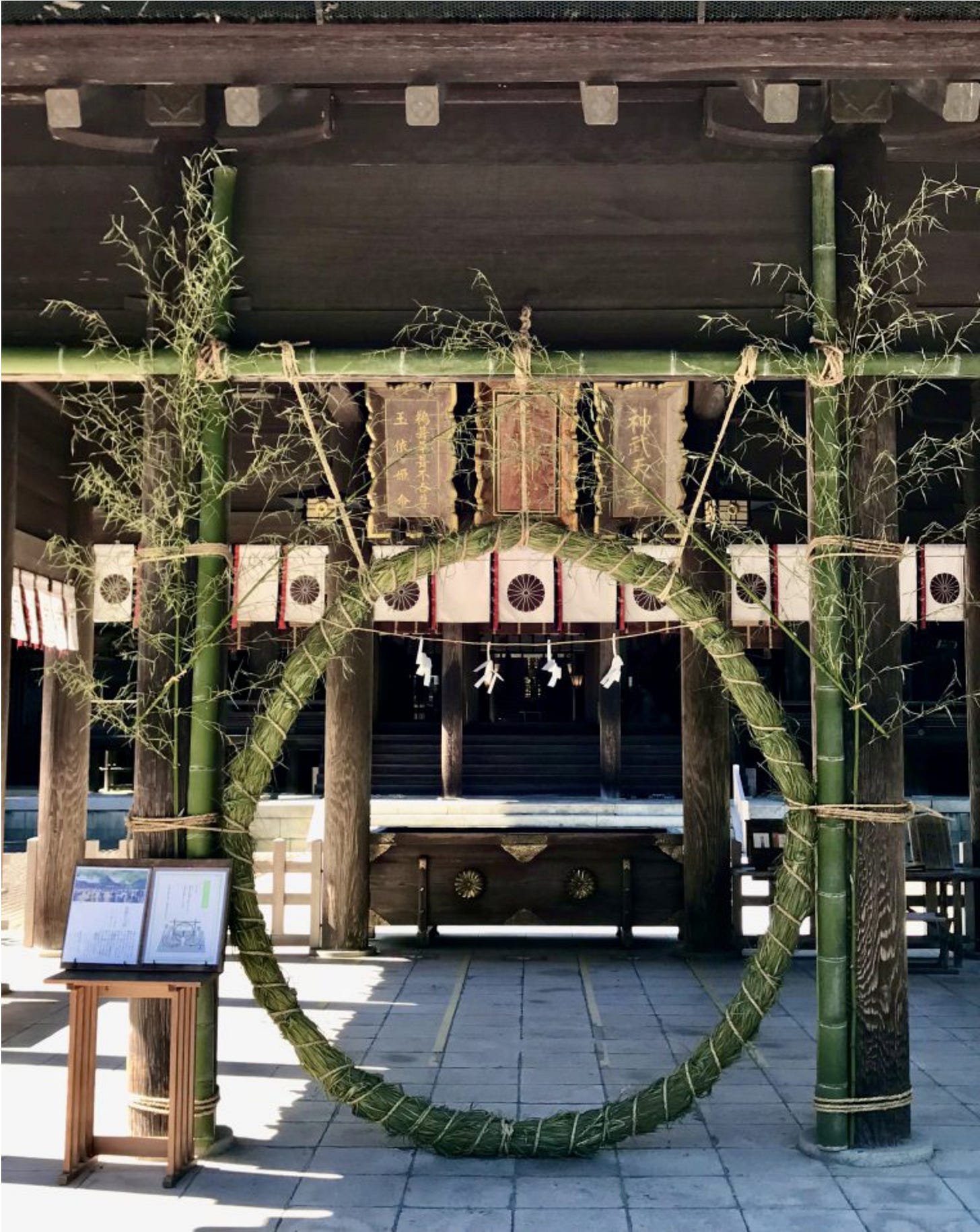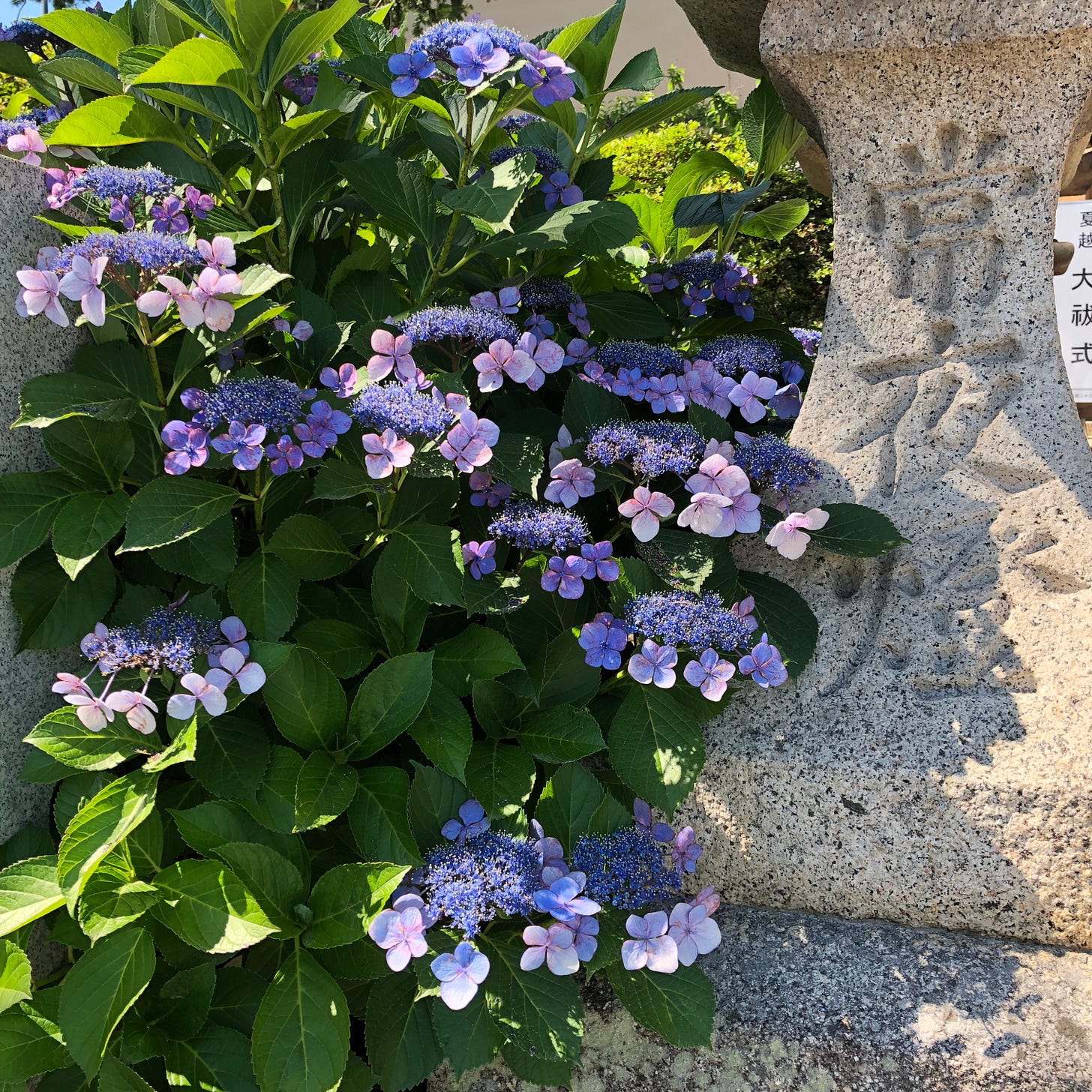At the Turn of the Half-Year
As the sun lingers longer in the sky and the air grows heavy with summer’s approach, there comes a moment when we instinctively sense the need to pause — to take stock of the months that have passed and to prepare our hearts for the path ahead.
In Japan, this quiet turning point of the year is not merely marked by the turning of the calendar, but by rituals that invite us to cleanse, to renew, and to step forward lighter in spirit. It is at this threshold that Nagoshi-no-Ōharae (夏越の大祓 なごしのおおはらえ), the Great Purification of the Summer Passing, welcomes us.
If you are in Japan around June 30th, you may be fortunate enough to witness this sacred ceremony. And for those not in Japan, I hope that through these words, the spirit of this ancient, elemental rite will find its way to you.
Japan is home to countless shrines, each with its own unique rituals and calendar. While the timing and details of ceremonies vary from shrine to shrine, certain seasonal observances are shared widely. Nagoshi-no-Ōharae is one of these — a ceremony performed at approximately 70 to 80 percent of shrines that have resident priests. (In Japan, there are more shrines than priests, so we speak in these terms.)
In this first post on Nagoshi-no-Ōharae, I would like to share the heart of two sacred elements: katashiro (形代 かたしろ), the human-shaped effigy, and chinowa (茅の輪 ちのわ), the grass ring.


Katashiro: A Vessel for Inpurity
Transferring Our Burdens to the Effigy
In the Ōharae ceremony, small figures made of paper or straw — known as katashiro (形代 かたしろ) or hitogata (人形 ひとがた)— are used to represent each individual. We breathe upon them, touch them, or pass them over our bodies, transferring to them the unseen burdens we carry: fatigue, mistakes, misfortune.

From Water to Fire: Returning to Nature
The practice draws from a deep belief in the power of transference — that impurity can be passed from body to object, and from there to nature’s cleansing forces. Once blessed, the katashiro are set adrift on rivers or seas, or burned, releasing what no longer belongs to us back to the natural world.
In Japanese, there is a phrase: mizu ni nagasu (水に流す), which means “to let something flow away in the water.” It expresses the idea of setting aside past troubles or grievances between people — of wiping the slate clean and starting anew. Water, in this sense, is a symbol of resetting everything to zero and being born again, fresh and unburdened.
Today, out of consideration for the environment, many shrines perform a symbolic act of casting the katashiro into water, then retrieve them afterward for proper disposal or conduct purification by fire. At the shrine where I serve, after the impurity has been transferred to the katashiro, the chief priest transfers it once more onto a sheet of fine paper. The paper is then torn into eight pieces, a ritual act that signifies the complete dissolution of impurity. Afterward, the katashiro are burned, receiving the final purification by fire.
Chinowa: A Circle of Grass

The Story of Somin Shōrai and the Ring of Grass
Another symbol of Ōharae (大祓 おおはらえ) is the chinowa (茅の輪 ちのわ), the ring woven of chigaya (茅 ちがや), a hardy grass known for its purifying strength. The act of stepping through this ring is more than tradition; it is a passage into renewal.
The origins of this practice are rooted in an old tale of Somin Shōrai (蘇民将来 そみんしょうらい), a poor man who welcomed a divine traveler when others turned him away. In gratitude, the traveler taught him how to ward off calamity: by wearing a ring of grass.
Embracing the Wild Kami
That traveler was no ordinary kami. In some tellings, he is described as Susanoo-no-Mikoto (須佐之男命 すさのおのみこと), a god known for stirring storms and bringing both blessings and destruction — a kami of wild power, sometimes associated with plagues and disasters. In other versions, the traveler is spoken of as a personification of the plague deity itself.
In Shinto, even such forces — those that bring illness, storms, or misfortune — are embraced as kami. They are not demons to be shunned, but sacred powers to be acknowledged, respected, and harmonized with. This idea is beautifully captured in Spirited Away, in the episode where a putrid, sludge-covered spirit — initially feared as a pollution god — is revealed, after cleansing, to be a revered river spirit. The story of Somin Shōrai reminds us that the path to protection lies not in rejection, but in hospitality: by opening one’s home and heart even to the kami of plague, one finds the means to survive and thrive.

Chigaya in Shinto Rituals
A Sacred Weed at the Edge of Daily Life
Chigaya grows along riverbanks, in fields, and on the ridges of rice paddies — always close to the daily lives of the people. Strong and resilient, it has long been used for thatched roofs, straw sandals, and simple sacred boundaries. Because of its familiar presence, it naturally came to be used in Shinto rituals. Chigaya is believed to have the power to ward off evil and purify. People would wear small rings of chigaya for protection, or pass through a large ring — the chinowa — to avoid misfortune and greet each day with a refreshed spirit. In this way, chigaya serves as a humble yet powerful link between daily life and the sacred.
Harvesting Chigaya: A Priest’s Work with Nature
That said, because of its vigorous growth and tall stalks, chigaya is often regarded as a troublesome weed in modern cities. In densely populated areas, it has become difficult to find places where chigaya grows in clusters. For this reason, priests at urban shrines often drive out to the outskirts in small farm trucks to cut and gather enough chigaya themselves for making the sacred chinowa.
I still remember one of my own training experiences — a day when I set out with senior priests to harvest chigaya…
During my training at a shrine in the city, I happened to be there just as it was time to gather chigaya. Together with senior priests, we set out by car, driving about an hour into the mountains. We arrived at a vacant lot along a national road where clusters of chigaya, nearly two meters tall, swayed in the breeze.
The weather was damp, with light rain falling. Donning raincoats, we stepped into the dense grass, so tall and thick that we could barely see one another. We swung our sharpened sickles, cutting the chigaya.
After a while, I heard a sudden shout nearby — “Uwaaah!”
Parting the grass to look, I saw one of my senior colleagues — a man usually known for his stern demeanor — startled because he had unknowingly grabbed a small frog clinging to a stalk of chigaya.
Once we had harvested enough, we loaded the chigaya onto the bed of the small truck, covered it with a tarp, tied it down with ropes, and headed back to the shrine.
Not long after, from the shrine’s purification bath area, we heard another shout — “Uwaaah!”
It turned out that the same senior priest had found a leech on his back, with blood running down. Though he was always strict and composed, he had a particular dislike for slimy creatures.
Shinto rituals are woven into the fabric of daily life in Japan. They are performed using what is close at hand — the plants, water, soil, and other gifts of nature that surround us. And so, the priests who conduct these rituals must also step into nature with their own hands, learning firsthand what it means to live in harmony with the world. Even my senior colleague, on that memorable day, was learning to find harmony... with the slimy creatures of the wild!

Closing Reflection
Through the humble forms of katashiro and the graceful arc of the chinowa, Nagoshi-no-Ōharae invites each of us to release what no longer serves us and to walk forward with a purified heart. These ancient rites, born from the rhythms of nature and the wisdom of those who came before us, remind us that renewal is always within reach. As we pass through the grass ring or set our burdens afloat, we are gently returned to harmony — with the world, with the unseen forces that shape our lives, and with ourselves.
If you happen to be living in Japan now, or if you will be visiting Japan around June 30th, I encourage you to visit a few shrines. You may have the chance to witness this beautiful ceremony. Toward the end of June, you will also find some shrines offering katashiro purification rites. And if you come across one, take it as a sign of good fortune — and summon the courage to try it for yourself!
Next Post
In my next post, I will introduce the Ōharae-shi(大祓詞) — the long, ancient Japanese prayer recited during the Nagoshi-no-Ōharae ceremony. Normally, norito (Shinto ritual prayers) are composed for each occasion and reflect the local character of the ceremony, but the Ōharae-shi is a fixed, time-honored prayer.
Its story tells of the deities who carry away impurities, passing them along like a baton in a relay, until the defilements are taken far, far away and quietly vanish, becoming part of the atmosphere itself.
It is impossible to translate this prayer into English in a way that fully preserves its original nuance — but I will do my best to convey its spirit as closely as possible.
Of course, I will share the original ancient pronunciations in Roman letters as well!
I look forward to receiving more comments! I’m so happy to see the comment section so lively.






Your way with words is an absolute delight to read every time, and I find myself seeing the scenes you describe in my head when reading!
I especially loved the image of a stern man being alarmed by a frog! I think sometimes folks from the west are so used to priests being these serious-separated individuals that they forget they're just like us.
I was very lucky to get to experience Nagoshi no Ōharae at several shrines in Kyoto when I was living there. One was Kitano Tenmangū, where on a rainy day we all gathered and chanted the Ōharae alongside the priests. And later were lead through the Chi no Wa in groups by one of the many priests there. And the other was that evening at Kamigamo Shrine, seeing the katashiro float down the river lit by torches while the Ōharae was echoing over speakers was a very mystical sight.
I had a vague understanding of the story behind the Chi no Wa but not the exact details of the meanings of it, so I appreciated hearing your interpretation of the story and learning more about what it means!
Thanks again! I look forward to reading your next article.
Thank you so much for this post. I have been intrigued by Nagoshi no Oharae and so I really appreciate you explaining more about it. I am curious as to whether someone not living in Japan could replicate any part of this ceremony? For example, could you create your own katashiro to burn, or is this something that can only be done by a shrine? I wish I could visit Japan at this time but unfortunately it won't be possible this year. Thank you again for sharing your knowledge, as always I am very grateful.